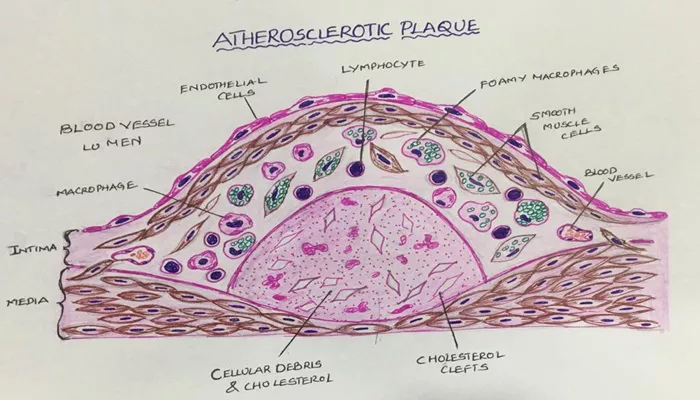Atherosclerosis is a condition characterized by the buildup of plaques in the arteries, which can lead to serious cardiovascular diseases, including heart attacks and strokes. This condition develops gradually over time and is influenced by various factors such as diet, lifestyle, and genetics. One of the most significant lifestyle factors that can impact atherosclerosis is exercise. There is ongoing research into whether regular physical activity can not only halt the progression of atherosclerosis but also promote the regression of existing plaques. This article explores the relationship between exercise and atherosclerosis, examining whether exercise can indeed reduce plaques in the arteries.
What Is Atherosclerosis?
Atherosclerosis is a complex disease that involves the accumulation of lipids, cholesterol, and other substances in the arterial walls, forming plaques. These plaques can narrow the arteries, restricting blood flow and increasing the risk of cardiovascular events. The process of atherosclerosis begins with damage to the endothelium, the inner lining of blood vessels, often caused by factors such as high blood pressure, smoking, and high cholesterol levels.
As the disease progresses, the plaques can become unstable and rupture, leading to the formation of blood clots that can block blood flow. This can result in serious health complications, including heart attacks and strokes.
The Role of Exercise in Cardiovascular Health
Regular physical activity is widely recognized as an essential component of a healthy lifestyle. Exercise has numerous benefits for cardiovascular health, including:
Improving blood circulation: Exercise enhances blood flow and oxygen delivery to tissues, which can help maintain healthy arterial function.
Lowering blood pressure: Regular physical activity can help reduce high blood pressure, a significant risk factor for atherosclerosis.
Improving lipid profiles: Exercise can increase levels of high-density lipoprotein (HDL) cholesterol, often referred to as “good” cholesterol, while lowering low-density lipoprotein (LDL) cholesterol and triglycerides.
Reducing inflammation: Regular exercise has anti-inflammatory effects, which can help reduce the risk of atherosclerosis and other cardiovascular diseases.
see also: What Is The BUN Level for Heart Failure?
Can Exercise Reduce Atherosclerotic Plaques?
The question of whether exercise can reduce atherosclerotic plaques has been the subject of extensive research. While the primary goal of exercise is often to prevent the progression of atherosclerosis, evidence suggests that it may also promote plaque regression in some individuals.
Evidence Supporting Plaque Regression
Clinical Trials: Several clinical trials have investigated the effects of exercise on atherosclerosis. One notable study, the Lifestyle Heart Trial, demonstrated that patients with coronary artery disease who engaged in regular exercise, along with dietary changes, experienced a reduction in the size of their atherosclerotic plaques after one year.
Animal Studies: Research involving animal models has shown promising results regarding exercise and plaque regression.
For instance, studies on mice have indicated that exercise can suppress the formation of fatty streaks and reduce plaque size compared to sedentary controls.
Mechanisms of Action: The potential mechanisms by which exercise may promote plaque regression include:
Enhanced Lipid Metabolism: Exercise improves lipid profiles by increasing HDL levels and decreasing LDL levels, which can help reduce plaque formation.
Increased Collagen and Elastin: Exercise may promote the production of collagen and elastin in arterial walls, leading to stronger and more stable plaques.
Reduction of Inflammatory Cells: Regular physical activity can help clear macrophages and foam cells from plaques, potentially leading to plaque regression.
Long-Term Benefits: Long-term adherence to an exercise regimen has been associated with improved cardiovascular outcomes. Studies have shown that individuals who maintain regular physical activity throughout their lives have a lower risk of developing significant atherosclerosis compared to sedentary individuals.
Considerations for Exercise in Atherosclerosis Management
While the evidence supporting the benefits of exercise in reducing atherosclerotic plaques is promising, there are several important considerations to keep in mind:
Intensity and Duration: The intensity and duration of exercise can significantly impact its effects on atherosclerosis.
Moderate-intensity exercise, such as brisk walking or cycling, is generally recommended for most individuals. High-intensity exercise may have different effects on plaque composition and stability.
Individualized Approach: Each person’s response to exercise can vary based on factors such as age, fitness level, and underlying health conditions. It is essential to tailor exercise programs to individual needs and capabilities.
Combination with Other Interventions: Exercise should be viewed as part of a comprehensive approach to managing atherosclerosis.
Combining regular physical activity with dietary changes, medication, and other lifestyle modifications can enhance overall cardiovascular health.
Monitoring and Guidance: Individuals with existing cardiovascular conditions should consult with healthcare providers before starting an exercise program. Monitoring and guidance can help ensure safety and effectiveness.
Conclusion
In conclusion, exercise plays a vital role in the prevention and management of atherosclerosis. While the primary goal of regular physical activity is to halt the progression of the disease, there is growing evidence to suggest that exercise may also promote the regression of atherosclerotic plaques in some individuals.
By improving lipid profiles, reducing inflammation, and enhancing overall cardiovascular health, exercise can be a powerful tool in the fight against atherosclerosis. However, it is essential to approach exercise as part of a comprehensive strategy that includes dietary changes, medication, and regular monitoring.


